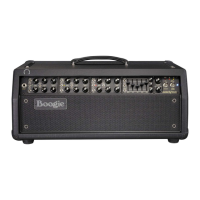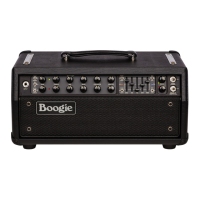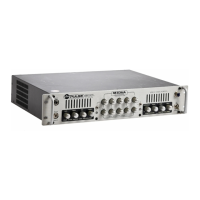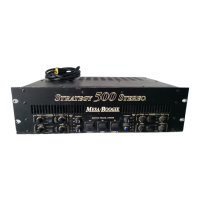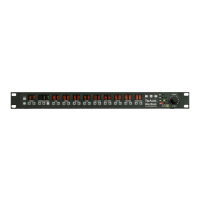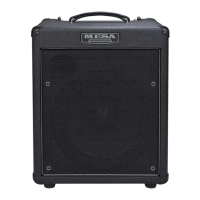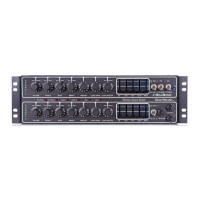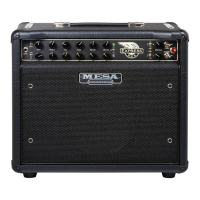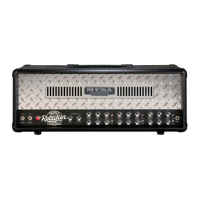PAGE 13
For the best performance in live miked applications where either large sound reinforcement is in place, or
you are capturing performances that involve footswitching between Channels set to dierent power levels in
a studio, we suggest using the amplifier in either 90 Watts or 45 Watts wherever possible as opposed to the
25 Watt option, as there will be less change in voltage in the power section and therefore noise derived from
potential voltage changes will be minimized.
NOTE: As with the 45 Watt setting, for a bolder, brighter response in the 25-watt setting, try moving the speaker cabinet
from the 8 OHM SPEAKER output over to the 4 Ohm SPEAKER output. The impedance will be a more correct match due to
the fact you are using a dierent tap on the transformer and two fewer power tubes.
CHANNEL 1
Channel 1 will likely become your “Rhythm” Channel, due to its two clean/ traditional gain Modes, CLEAN and
FAT, with FAT being repeated in Channel 2 for maximum flexibility in the traditional gain domain. These two
Modes provide two dierent “clean chording” characters and EQ Curves, with CLEAN being the more stripped,
tight, and percussive of the two.
FAT follows it up with a bigger low end and richer low mids, which provides for wider, fatter, more 3-D sound-
ing rhythm parts, and also, some nice round options for single note soloing when set appropriately (thoughtful
BASS settings).
CRUNCH completes Channel 1 and brings it home for those into clipped/overdriven chording and/or single note
work. It’s got much higher gain than either CLEAN or FAT but also stays tight and percussive in comparison to
the higher gain “Lead Modes” found in Channels 2 and 3. CRUNCH is saturated in most of its range but not
so much that it compresses and slows things down, so the dynamic response is great for rhythmic styles that
have some overdrive in their makeup.
Like FAT for clean work, CRUNCH is also repeated in Channel 2 to increase flexibility in overdrive for the rhythm
sector. This allows one setting of CRUNCH in Channel 1 optimized for pushed chording or throaty single note
grooves, while another dierent setting of CRUNCH can be called up in Channel 2 for higher gain work, be it
heavier chording or soloing. And since CRUNCH roams the range between the edge of clean and overdrive so
adeptly, you might also set CRUNCH in Channel 1 for a soft-clip clean response and set CRUNCH in Channel
2 a bit higher for classic rock chording.
Having this flexibility and being able to dedicate two Channels to dierent settings of the same sounds/Modes
makes ultimate footswitching sense, along with the myriad of options possible when you don’t “clone” the
Channels. Either route you decide to take to your ultimate Tone and footswitchable palette, you’ll find the three
Modes that make up Channel 1 are Classics, one and all, and give you many ways to craft your Tone.
CLEAN
This is the lowest gain Mode in the MARK SEVEN, and many will view it as a Rhythm Channel. That said, it
can be used for anything that suits your musical style, from clean comping to pushed single-note soloing and
anything in between that doesn’t require more than traditional gain levels.
CLEAN is the “skinnier,” more stripped of the two traditional gain Modes in Channel 1. It is purposefully trimmed
in the low end to provide for tight, percussive chording that will fit snugly into a mix, especially one heavy in
instrumentation or having layered keyboard and vocal parts. This lack of sub-low end provides for maximum
definition within a rhythmic framework, increases accuracy, enhances dynamic response, and works equally
well for both chording and single-note lines.
CLEAN also lends itself well to tightening up instruments that have large amounts of low-end or low mids in their
character. Hollow or semi-hollow guitars, or those instruments with shorter scale lengths, are often featured
best in CLEAN, as the less prevalent low end keeps them tighter and more articulate, especially for rhythmi-
cally complex work.
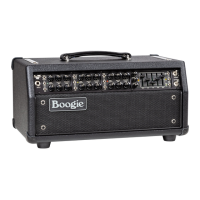
